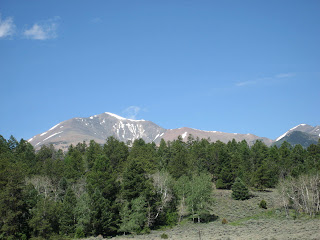Is conservation hopeless? I do not mean “will conservation efforts ultimately fail?” but “do conservation biologists perform their work without hope that it will make a difference?” A recent article in Bioscience (Volume 60, pages 626-630) argues that yes, researchers in conservation all too often function with a pessimistic outlook. The article points out that “A society that is habituated to the urgency of environmental destruction by a constant stream of dire messages from scientists and the media will require bigger and bigger hits of catastrophe to be spurred to action, and ultimately will give up hope that anything can be done.”
This notion of too much doom and gloom has been presented before, but this paper also suggests concrete solutions. I thought the most striking was the suggestion that conservation-oriented journals request that submitted articles possess, in addition to the usual concluding section on management implications, a section on hope. This section would focus on how the study offers hope for a better future.
Another interesting aspect of the paper was the implicit assumption that researchers studying conservation-related issues should be advocates for change. Some would argue that researchers should remain as objective as possible to avoid potential bias in their work. Many elements of science are inherently subjective, but it is not a settled matter that conservation biologists are advocates – that is worthy of debate as well.
On a different note, I recently got out pheasant hunting in Minnesota – beautiful autumn! – and snow has started to fly in Laramie. Ski season is not too far away.
READING
Swaisgood, Sheppard. 2010. The culture of conservation biologists: show me the hope! Bioscience 60:626-630.
Thursday, October 28, 2010
Wednesday, October 20, 2010
Summer travels



I enjoyed traveling around the west this summer and scouting potential field sites. (From the top, the Laramie River in Colorado; a spot along the road in central Colorado; and the Shoshone River in northern Wyoming.) Aside from having a raccoon take my shoes into the brush overnight while camping, my trips were productive and uneventful.
One of the other nice features of summer in Laramie (apart from the beautiful weather) is the farmer's market, which takes place every Friday. There are a fair amount of farms in southeastern Wyoming and northern Colorado that make the trip to Laramie for these markets, and they provide a nice selection of produce and meat.
Tuesday, October 19, 2010
Events and Community
It has been great to see everyone back on campus and around town after returning from summer field work, work through data, plan new projects, and get some writing done (lots more still to go!). A few events worth noting -
The ecology graduate students had a welcome back/welcome new students cookout, followed by a camping trip in Happy Jack (~20 minutes from Laramie):
E.O. Wilson came to Laramie and spoke about biodiversity loss and conservation for a public audience on campus. I can now mark him off of my science-heros-I'd-like-to-see-in-person list!
The Program in Ecology hosted Dr. Ray Callaway for our Distinguished Ecologist Speaker Series.
My home department, Zoology & Physiology, has a fall picnic every year as well. This year's get-together took place on a beautiful ranch owned by a retired professor just outside of Centennial and the Snowy Mountains (~30 minutes from Laramie):
And while I was near the Snowy Mountains for the department picnic, I decided to spend the morning hiking in Medicine Bow National Forest with the Snowies in the background. One of my favorite spots near Laramie, especially in late summer/early fall:
The University of Wyoming community is a great one, and I'm always amazed when my friends at other institutions are surprised that the faculty and students socialize as much as we do.
The graduate students are hosting two invited speakers for the Program in Ecology this semester, and I am looking forward to interacting with the speakers as well as the professors and students during those visits.
______________________________________________________________
READING: Guenet et al. 2010. Priming effect: bridging the gap between terrestrial and aquatic ecology. Ecology.
______________________________________________________________
The ecology graduate students had a welcome back/welcome new students cookout, followed by a camping trip in Happy Jack (~20 minutes from Laramie):
 |
| Program in Ecology Graduate Student Fall Camping Trip, Happy Jack, WY |
E.O. Wilson came to Laramie and spoke about biodiversity loss and conservation for a public audience on campus. I can now mark him off of my science-heros-I'd-like-to-see-in-person list!
The Program in Ecology hosted Dr. Ray Callaway for our Distinguished Ecologist Speaker Series.
My home department, Zoology & Physiology, has a fall picnic every year as well. This year's get-together took place on a beautiful ranch owned by a retired professor just outside of Centennial and the Snowy Mountains (~30 minutes from Laramie):
Zoology & Physiology Department Fall Picnic, Lindzey's Ranch near Centennial, WY |
And while I was near the Snowy Mountains for the department picnic, I decided to spend the morning hiking in Medicine Bow National Forest with the Snowies in the background. One of my favorite spots near Laramie, especially in late summer/early fall:
| Snowy Mountains, Medicine Bow National Forest, WY |
The University of Wyoming community is a great one, and I'm always amazed when my friends at other institutions are surprised that the faculty and students socialize as much as we do.
The graduate students are hosting two invited speakers for the Program in Ecology this semester, and I am looking forward to interacting with the speakers as well as the professors and students during those visits.
______________________________________________________________
READING: Guenet et al. 2010. Priming effect: bridging the gap between terrestrial and aquatic ecology. Ecology.
______________________________________________________________
Subscribe to:
Comments (Atom)